Breeds of Chickens - NOPQ
A |
B |
C |
DEFG |
HIJ |
KL |
M |
NOPQ |
R |
S |
TUVWXYZ
|
 Naked Neck Naked Neck
|
|
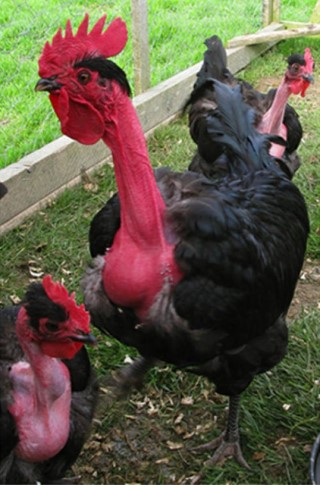 Naked Neck
chickens (also known as Transylvanian Naked Necks or Turken) are a breed of
chicken that is naturally devoid of feathers on its neck and vent. They originally
are from Transylvania and were largely developed in Germany.
Naked Neck
chickens (also known as Transylvanian Naked Necks or Turken) are a breed of
chicken that is naturally devoid of feathers on its neck and vent. They originally
are from Transylvania and were largely developed in Germany.
They are often
referred to as Turkens because of the mistaken idea that they were a hybrid of
a chicken and a turkey. Naked Neck chickens are fairly common in Europe today,
but are rare in North America and very common in South American.
The naked neck
trait is dominant and is fairly easy to introduce into other breeds. There are
other breeds of naked necked chicken, such as the French naked neck or Italian
Naked neck, which is often confused with the Transylvanian.
|
 |
|
 Nankin Bantams Nankin Bantams
|
|
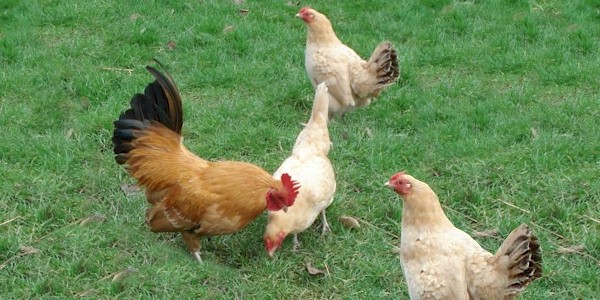 Nankin Bantams, or just Nankins, are a British bantam
chicken. They are a true bantam, a naturally small breed with no large
counterpart from which it was miniaturized. They yellowish buff colored, and
the name is thought to derive from the color of Nankeen cotton from China.
Nankin Bantams, or just Nankins, are a British bantam
chicken. They are a true bantam, a naturally small breed with no large
counterpart from which it was miniaturized. They yellowish buff colored, and
the name is thought to derive from the color of Nankeen cotton from China.
There are two varieties of Nankin chickens, differentiated
by comb type; the single comb Nankin has a large comb with five points, and the
rose comb has a medium size one ending in a single point. All Nankins come in a
single color, with buff on the body and black tails. The golden hue is deeper
and more lustrous in males, and they have the longer sickle feathers common in
cocks. Their beaks are a light horn color, and legs are slate blue.
...
|
 |
|
 New Hampshire New Hampshire
|
|
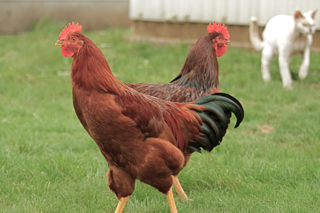 New Hampshire,
or New Hampshire Red, chickens were developed to be quick with eggs and heavy
with meat. They tend to produce quite a lot of brown eggs each year. They
mature quickly, meaning they can be fattened up and cooked much sooner than
other breeds.
New Hampshire,
or New Hampshire Red, chickens were developed to be quick with eggs and heavy
with meat. They tend to produce quite a lot of brown eggs each year. They
mature quickly, meaning they can be fattened up and cooked much sooner than
other breeds.
New Hampshire
Reds are very easy to tame and are generally very friendly. They are laid back
and content to just lay eggs and be raised for dinner. Despite being so
relaxed, they are quite active and do well in a nice open space where they can
run about and forage. When kept with their same breed, the issue of aggression
doesn''t generally come up.
New Hampshire
Reds are big birds with their distinctive red color with bluish or black
feathers on the end of the ta
...
|
 |
|
 Norfolk Grey Norfolk Grey
|
|
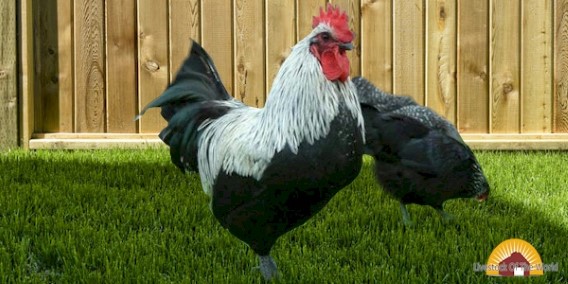 Norfolk Grey
chickens are a dual-purpose that originated in Norfolk, England, around 1910.
Norfolk Grey
chickens are a dual-purpose that originated in Norfolk, England, around 1910.
They were
originally created by Frederick W Myhill of Hethel, Wymondham under the name
Black Maria. It is believed that he used Birchen English Game and possibly
Duckwing Leghorns. The game inclusion would account for the excellent meat
ability and the Leghorn for the laying ability.
During the
First World War, they were allowed to free range while Myhill had departed for
military service. On his return, he discovered that the birds had cross bred
with other breeds and the strain had to be recreated. In 1925, Myhill applied
to the Poultry Club of Great Britain in 1925 to have the name changed to
Norfolk Grey as th
...
|
 |
|
 Norwegian Jaerhones Norwegian Jaerhones
|
|
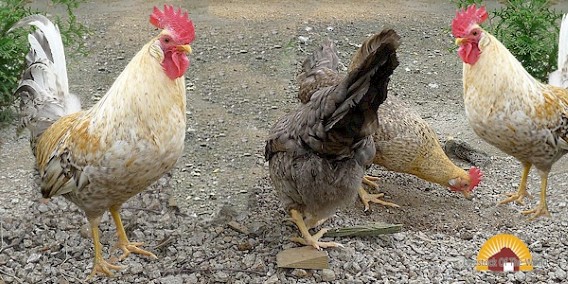 Norwegian Jaerhones are auto-sexing chickens developed in the 1920s from local breeds in the Jæren district of Norway.
Norwegian Jaerhones are auto-sexing chickens developed in the 1920s from local breeds in the Jæren district of Norway.
Jaerhones were the principal chicken breed of Norway until imports of foreign breeds began in the nineteenth century. They were selectively bred at the state-controlled breeding station at Bryne in Jaeren from its establishment in 1916 until it closed in 1973. Breeding stock were then transferred to the state agricultural college at Hvam, Nes.
They come in two color varieties: dark brown and yellow, and light brown and yellow. They have a single comb and their beak and legs are bright yellow.
A miniature version with the same two color varieties was approved in 1994.
Jaerhones
...
|
 |
|
 Old English Gam Old English Gam
|
|
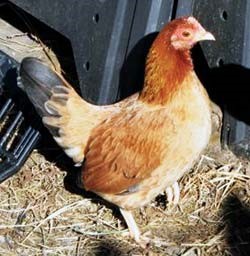 Old English
Game are one of the most popular show chickens with fanciers, which is
fortunate because they don''t provide a lot of meat and they aren''t very good
layers.
Old English
Game are one of the most popular show chickens with fanciers, which is
fortunate because they don''t provide a lot of meat and they aren''t very good
layers.
Old English
Games are quick to be trained to their handlers, becoming friendly and calm
almost instantly, making them a wonderful choice to have around children.
Younger roosters will fight once in a while, but this is common with most any
breed. In addition, the hens are so tolerant that they have no problem sharing
space with even hens of other breeds. They are perfectly fine with little space
and keep fairly quiet, so they are a good choice for a residential area.
Despite being
a bantam and therefore small, Old English Games are str
...
|
 |
|
 Orloff Orloff
|
|
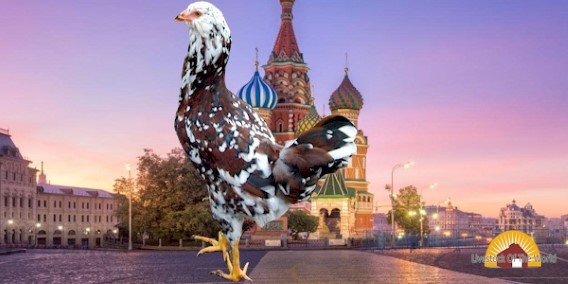 Orloff, also
known as Russian Orloff, chickens are named after Alexei Grigoryevich Orlov, a
Russian Count. For most of its history, the Orloff was considered to be a
product of Russia and Orlov, but modern research has discovered that the breed
first appeared in Persia, and was distributed across Europe and Asia by the 17th
century. However, Count Orlov was a key promoter of the breed in the 19th
century, and the breed became known in the West following his efforts.
Orloff, also
known as Russian Orloff, chickens are named after Alexei Grigoryevich Orlov, a
Russian Count. For most of its history, the Orloff was considered to be a
product of Russia and Orlov, but modern research has discovered that the breed
first appeared in Persia, and was distributed across Europe and Asia by the 17th
century. However, Count Orlov was a key promoter of the breed in the 19th
century, and the breed became known in the West following his efforts.
Orloffs were
first introduced to Great Britain in the 1920s, and were also refined a good
deal in Germany; Germans created the first miniaturized Orloff by 1925. They
were once included in the American Poultry Association''s breed standard, the
Standard
...
|
 |
|
 Orpingtons Orpingtons
|
|
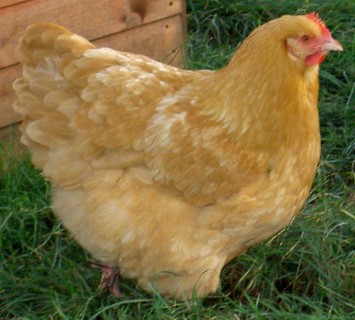 Orpingtons are
all around great birds. They can lay up to 200 eggs in a year, are thick and
meaty birds for cooking, and are easily relaxed for showing. They tend to be a
good choice for any chicken enthusiast just getting into the hobby or for any
farmer needing a top-notch reliable chicken around the yard.
Orpingtons are
all around great birds. They can lay up to 200 eggs in a year, are thick and
meaty birds for cooking, and are easily relaxed for showing. They tend to be a
good choice for any chicken enthusiast just getting into the hobby or for any
farmer needing a top-notch reliable chicken around the yard.
Orpingtons are
friendly and relaxed, so much so that they can be training to feed from the
hand. They are perfectly content in confinement, which goes along with why they
make such good show chickens. They''re very active and like to explore, yet they
aren''t too concerned when there isn''t too much space to do so. They tend to
like each other and don''t get into arguments or squabbles either.
Or
...
|
 |
|
 Pekin Bantam Pekin Bantam
|
|
 Pekin bantams
are a Chinese True bantam, a breed of miniature chicken which has no large
version. The first Pekins are
believed to have been taken from the private collection of the Emperor of China
at Peking (now known as Beijing) by British soldiers towards around 1860.
However, some sources suggest that a consignment of birds from China around
1835 were given to Queen Victoria, and that these birds were bred with further
imports and were developed into the breed we know today as Pekin Chickens.
Pekin bantams
are a Chinese True bantam, a breed of miniature chicken which has no large
version. The first Pekins are
believed to have been taken from the private collection of the Emperor of China
at Peking (now known as Beijing) by British soldiers towards around 1860.
However, some sources suggest that a consignment of birds from China around
1835 were given to Queen Victoria, and that these birds were bred with further
imports and were developed into the breed we know today as Pekin Chickens.
Pekin bantam look
like a miniature version of Cochin chickens and are often known in the United
States and Canada as Cochin Bantams. However, they are unrealted.
Pekin bantams possess a wealth of feathering abo
...
|
 |
|
 Penedesencas Penedesencas
|
|
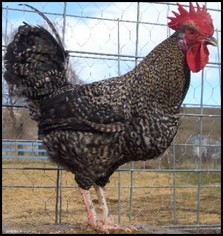 Penedesencas are
Spanish chickens that are best known for laying large qualities of brown eggs.
In fact, no other breed can produce eggs as dark as the Penedesenca can. They
are a rare breed, though they still work well as a meat bird due to their
hearty build.
Penedesencas are
Spanish chickens that are best known for laying large qualities of brown eggs.
In fact, no other breed can produce eggs as dark as the Penedesenca can. They
are a rare breed, though they still work well as a meat bird due to their
hearty build.
They have a
very unique comb that starts as a single comb but splits into multiple combs
near the back of the head. They have red ear-lobes with white centers despite
laying brown eggs, red combs, and red wattles. There are four varieties, the
Wheaten, the Partridge, the Crele, and the Black, each with slightly different
color schemes, all with black beaks and legs, save for the Crele which has
white beaks and legs.
Penedesenca chickens
are a very ac
...
|
 |
|
 Pepoi Pepoi
|
|
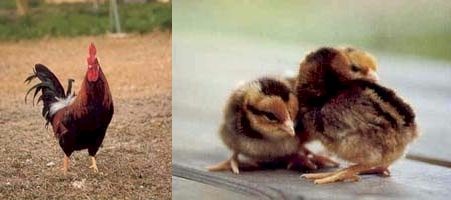 Pepoi is a bantam
breed. They are very common in Veneto and Friuli (North-East Italy). They are probably
the only Bantam rustic breed used for production. Pepoi can be easily reared
and are a good solution for the production of portion chicken. The breast has
good pectoral muscles, excellent for the spit; the meat is very tasty.
Pepoi is a bantam
breed. They are very common in Veneto and Friuli (North-East Italy). They are probably
the only Bantam rustic breed used for production. Pepoi can be easily reared
and are a good solution for the production of portion chicken. The breast has
good pectoral muscles, excellent for the spit; the meat is very tasty.
Mean laying:
160-180 (rose shell, 40-45 g).Great broodiness and aptitude to chicks care.
Content and photo
source: Agraria.org
|
 |
|
 Phoenixe Phoenixe
|
|
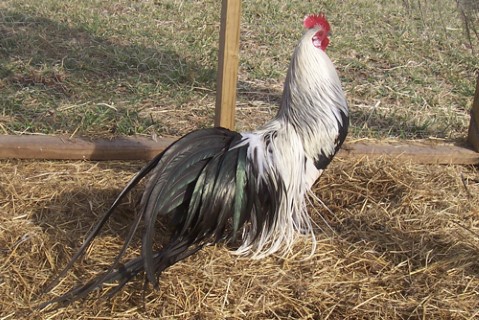 Phoenixes are
a show bird more than anything; they are extremely poor egg layers and their
body structure doesn''t make them very good fryers. Phoenix Chickens are best
known for their tail, which can grow to almost absurd proportions. They have an
average-sized single comb and medium length wattle, both a light red color.
Their colorings can various wildly from silver to black to gold to red to
brown. Their legs and beak are typically a light gray color.
Phoenixes are
a show bird more than anything; they are extremely poor egg layers and their
body structure doesn''t make them very good fryers. Phoenix Chickens are best
known for their tail, which can grow to almost absurd proportions. They have an
average-sized single comb and medium length wattle, both a light red color.
Their colorings can various wildly from silver to black to gold to red to
brown. Their legs and beak are typically a light gray color.
Phoenixes do
well in confinement, which is good because they''ll need lots of codling due to
their tail feathers. Their attitudes range from shy and calm to aggressive and
in-your-face. Generally though they aren''t very friendly and don''t like to be
pestered.
...
|
 |
|
 Pita Pinta Austuriana Pita Pinta Austuriana
|
|
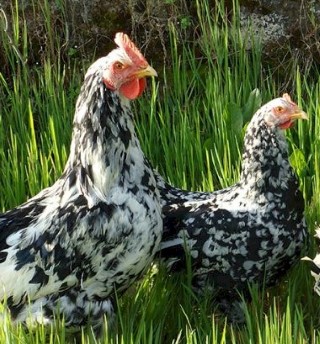 Pita Pinta Austuriana
chickens, also known as Asturian Painted Hen ,
belongs to the Atlantic branch of domestic chickens and has common ancestry
with other breeds in northern Spain, such as the Euskal Oiloa of the Basque
Country. Their name comes
from the Asturian language, in which pita means "hen" and pinta
meaning "painted" or “mottled”.
Pita Pinta Austuriana
chickens, also known as Asturian Painted Hen ,
belongs to the Atlantic branch of domestic chickens and has common ancestry
with other breeds in northern Spain, such as the Euskal Oiloa of the Basque
Country. Their name comes
from the Asturian language, in which pita means "hen" and pinta
meaning "painted" or “mottled”.
With the
industrialization of egg production in Asturias in the 1950s and 1960s, the
number of Pita Pinta Austuriana chickens dropped dramatically, almost to the
point of extinction. They started to recover between 1980 and 1990. A breeders''
association, the Asociación de Criadores de la Pita Pinta Asturiana, was
founded in 2003; its 52 members have a total of 1842 birds. In 2
...
|
 |
|
 Plymouth Rock Plymouth Rock
|
|
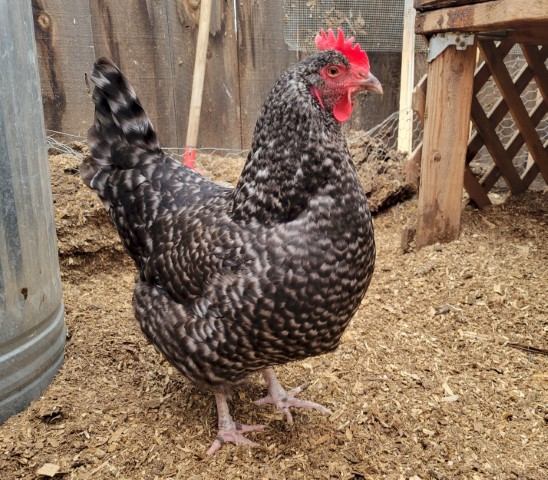 Plymouth Rock chickens were developed in New England in the middle of the 19th century as a dual-purpose fowl, meaning that they are valued both for their meat and for the hens'' egg-laying ability. The first Plymouth Rock was barred and other varieties were developed later.
Plymouth Rock chickens were developed in New England in the middle of the 19th century as a dual-purpose fowl, meaning that they are valued both for their meat and for the hens'' egg-laying ability. The first Plymouth Rock was barred and other varieties were developed later.
Plymouth Rock chickens were first exhibited as a breed in 1849. Several people claimed its invention, using crosses of Dominiques, Black Javas, Cochins, and perhaps Malays and Dorkings. John C. Bennett (1804–1867) has been credited with either creating or popularizing the breed.
Plymouth Rock chickens became popular very rapidly, and until World War II no breed was as popular in the United States as the Barred Plymouth Rock. They became so widely
...
|
 |
|
 Polish Polish
|
|
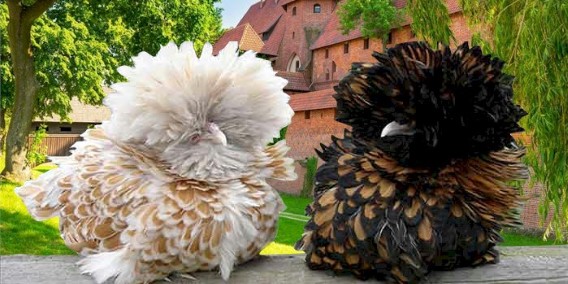 Polish (also known as Padovana of Chili or Polish Frizzles), chickens have a huge
bouffant crest of feathers and a v-shaped comb.
Polish (also known as Padovana of Chili or Polish Frizzles), chickens have a huge
bouffant crest of feathers and a v-shaped comb.
Though the derivation of
the Polish breed is unclear, one theory suggests that their ancestors were
brought by Asian Mongols to Eastern Europe during medieval times, and thus,
could have originated in Poland. It is also believed that immigrants could have
brought the breed''s predecessors from Spain or Italy in the late 16th century.
The Polish was standardized in the Netherlands and declared a thoroughbred in
the 16th century. Chickens bearing a strong resemblance to the Polish can be
seen in paintings from the 15th century, and they were extensively portrayed in
Dutch and Italian paintings
...
|
 |
|
 Poltavas Poltavas
|
|
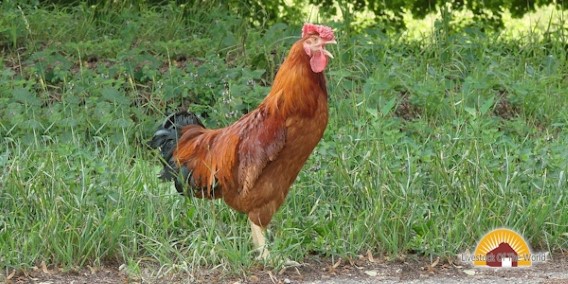 Poltavas are
an old Ukrainian dual-purpose chicken named after the Ukrainian city of
Poltava. It is believed that they were developed from local chicken breeds.
Poltavas are
an old Ukrainian dual-purpose chicken named after the Ukrainian city of
Poltava. It is believed that they were developed from local chicken breeds.
They are found
in Clay (the most common), Cuckoo, and Black. The tips of their flight feathers
are black and their tail is brown-black. Roosters have a lighter neck than
hens. Chicks are covered in light brown fuzz. They are very resistant and adapt
easily to any conditions. The rooster weighs about 3 kg, and hens weigh about 2
kg. They lay around 160-215 brown eggs per year.
They are
mainly used small ranches since their egg product and size is not attractive
for commercial use.
|
 |
|
 Polverara Polverara
|
|
 Polverara chickens stand as a testament to Italy''s rich poultry heritage, originating from the ancient village of Polverara in the Padua region. Dating back to the 15th century, they are also known as "Padovana di Polverara," "Schiatta di Polverara," or simply "Schiatta." There''s a debate among poultry historians about whether Polverara chickens are the ancestors of the Padovana breed or vice versa, highlighting their historical significance in Italian poultry breeding.
Polverara chickens stand as a testament to Italy''s rich poultry heritage, originating from the ancient village of Polverara in the Padua region. Dating back to the 15th century, they are also known as "Padovana di Polverara," "Schiatta di Polverara," or simply "Schiatta." There''s a debate among poultry historians about whether Polverara chickens are the ancestors of the Padovana breed or vice versa, highlighting their historical significance in Italian poultry breeding.
Despite their storied past, Polverara chickens faced near-extinction at one point, with their numbers dwindling. However, efforts are underway to revive this heritage breed, and it is officially recognized as a traditional product by the Italian Department of Ag
...
|
 |
Top
|